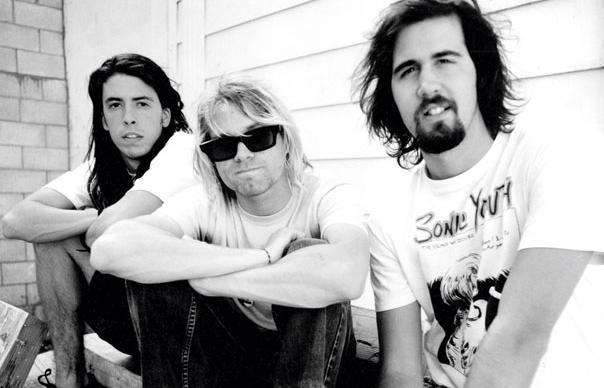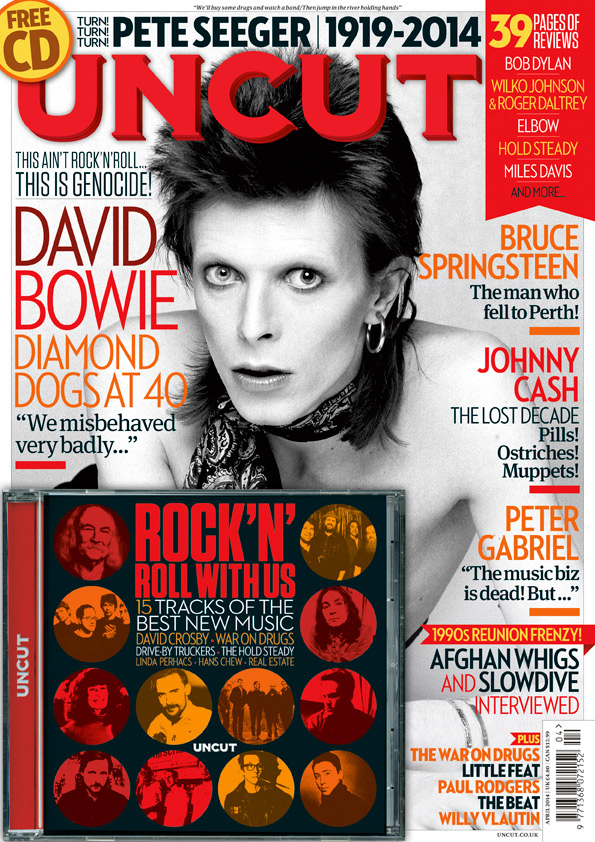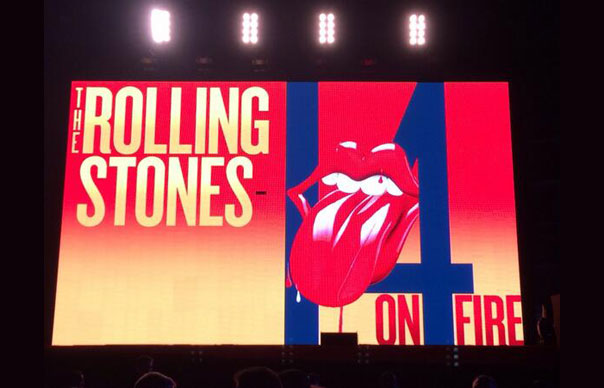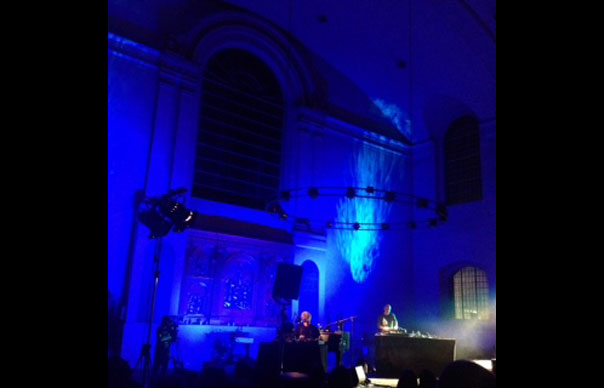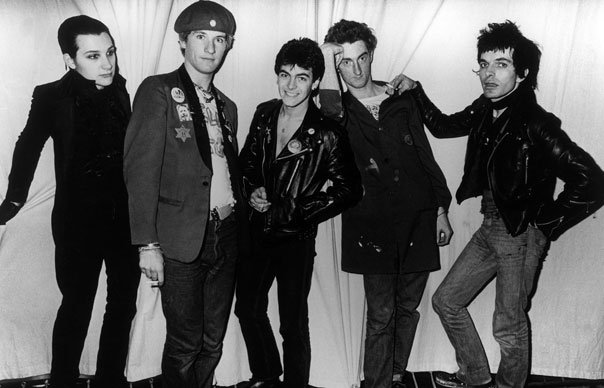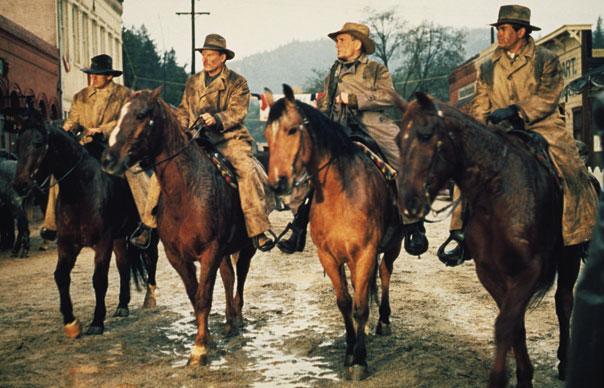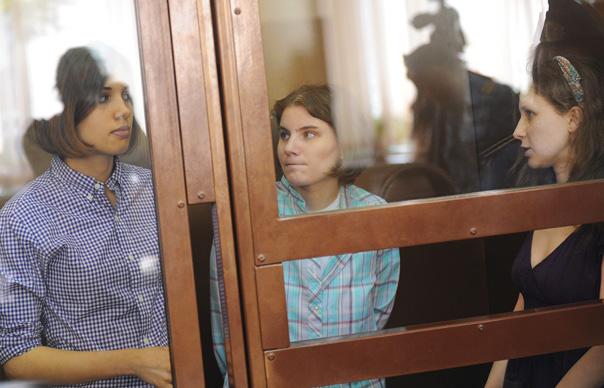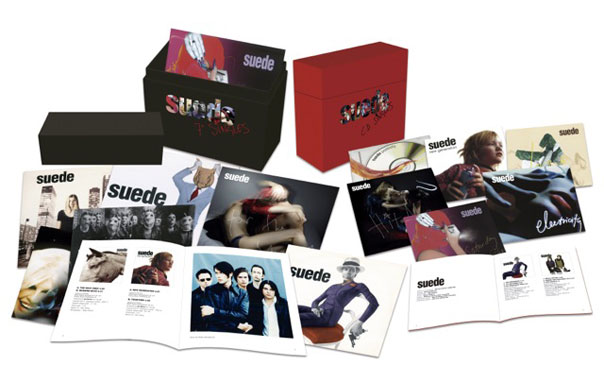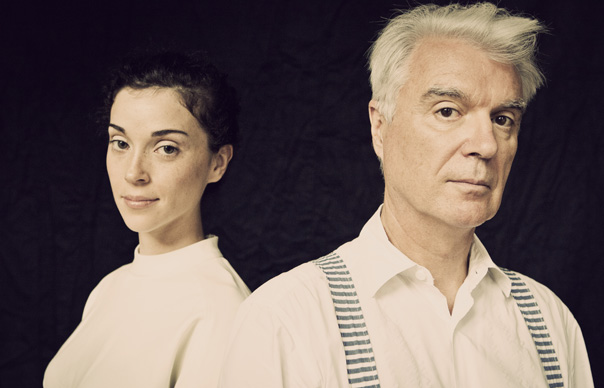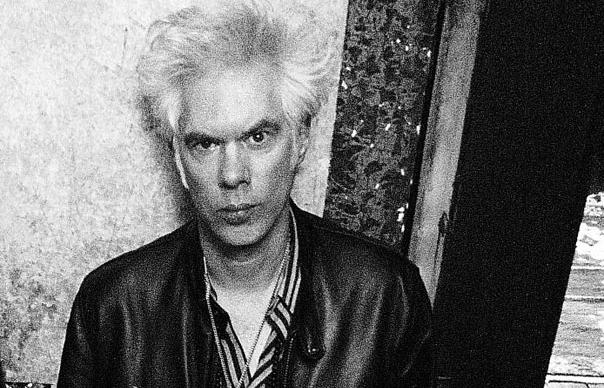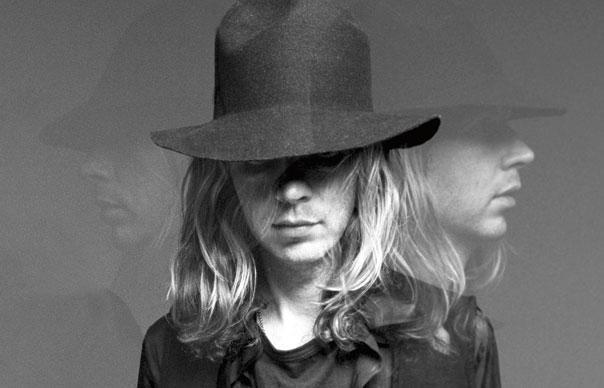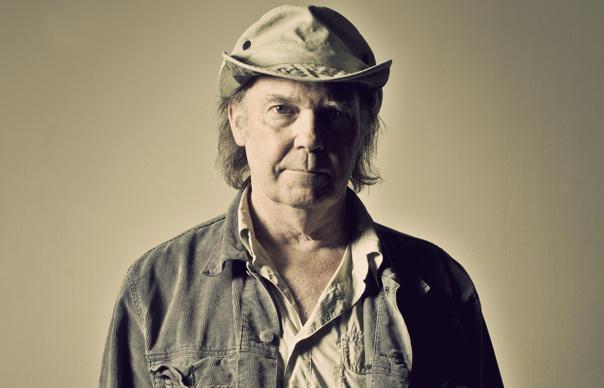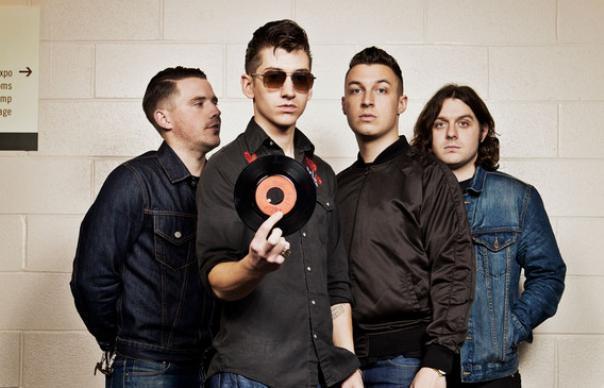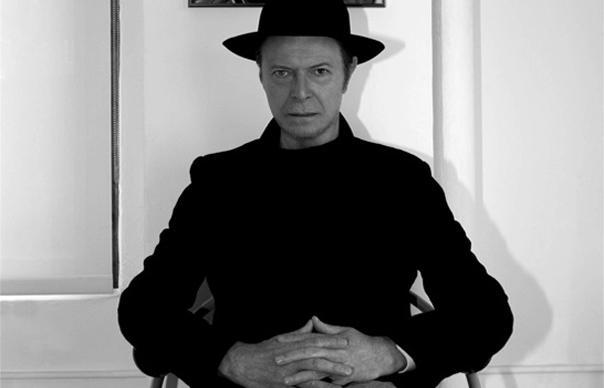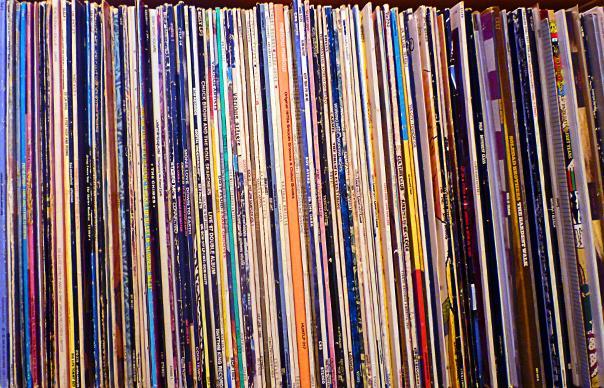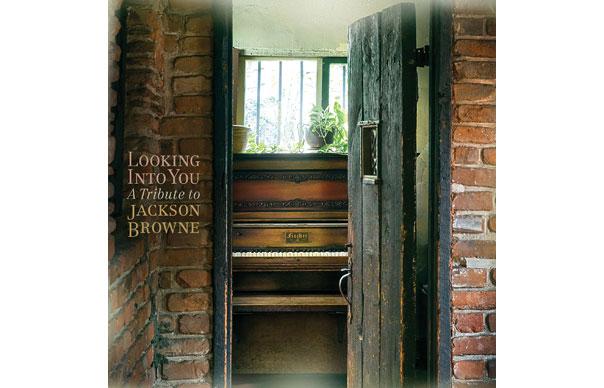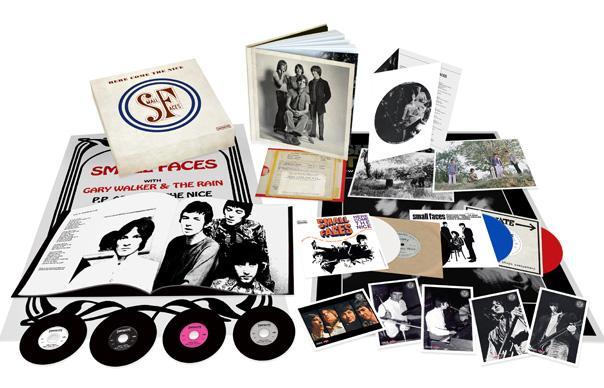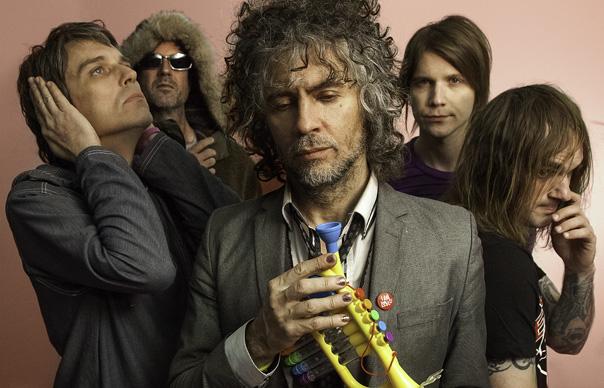St Vincent releases her self-titled fourth album on Monday (February 24) – here, from the Uncut archives (October 2012, Take 185), is a reminder of Annie Clark’s last project – Love This Giant, created with David Byrne. Gather round, then, as Byrne and Clark reveal the secrets of a successful art-rock team-up, swish parties at the French Ambassador’s residence, and being “allergic to cymbals”… Words: Peter Shapiro
___________________
It could be the heat doing crazy things to my brain, but as David Byrne paces around the office of his record label, Todo Mundo, I am struck by a strange thought. In his blue and white wide-wale seersucker trousers with matching braces, short-sleeve white cotton shirt and white flip-flops (to say nothing of his white hair and gradually whitening eyebrows), David Byrne resembles nothing so much as a giant ice lolly.
No-one, not even a freeze pop, wants to be in New York City in the middle of July, and today is why. It’s 100° Fahrenheit with 65 per cent humidity: walking in Manhattan is like trudging through a swamp of other people’s sweat and diesel exhaust. Then there’s the smell. Even on the genteel streets of Todo Mundo’s SoHo neighborhood, which is otherwise populated by swanky Comme Des Garçons boutiques, the fumes of dead rodents exude their unmistakable perfume like the devil’s own bougainvillea.
Although he rode his bike to work through these stifling streets (as he always does — after Lance Armstrong, Byrne is probably America’s most famous bicyclist), Byrne is totally cool and unruffled. A striking contrast, in fact, to the familiar sweaty, anxiety-ridden salary man he portrayed in Talking Heads’ video for “Once In A Lifetime”. Byrne’s Popsicle-like appearance today is only accentuated by the fairground cornucopia of tchotchkes and ephemera that is the Todo Mundo office. The walls are adorned with paintings of the apocalyptic visions of self-ordained minister Howard Finster (one of which was the cover for Talking Heads’ Little Creatures album), game fish taxidermy, pistol range targets complete with bullet holes, a Christopher Columbus jigsaw in which the explorer’s face has been replaced by a comic book’s metal skull, and a photo of an astronaut holding a cassette of Talking Heads’ first album. There is a shelf of a bookcase that functions as a shrine to the caprices of consumerism (at least to an American): tins of spotted dick and mushy peas, odd liqueurs from Turkmenistan, baldness cures, bongs in the shape of skeletons, and miniature statuettes of lucha libre wrestlers from Mexico. Elsewhere, a rather hideous and obscenely phallic cutaway model of an earthworm’s innards sits on top of a television set, conjuring long repressed memories of traumatic biology class dissections.
Byrne’s office may be a reliquary of capitalist detritus, but interior decoration aside, he’s never been interested in resting on his laurels and mummifying his past. Byrne could easily fund a comfortable retirement by donning The Big Suit from Stop Making Sense and churning through “Psycho Killer” and “Burning Down The House” until he needs to put his dentures in a glass. Instead, unlike most of his peers, he constantly has his ear to the underground and engages in quirky, charming art projects (like hooking up an old pipe organ to a disused building’s plumbing and ceiling beams so visitors can “play” the building) in order to satisfy his perpetually restless polymath imagination.
“In order to feed my own creative juices, part of that process is being inspired by what other people are doing,” Byrne says. “Not that I want to copy them or rip them off, it’s just keeping my juices flowing, hearing what’s new, hearing what people are doing. I do presume that keeping the creative juices flowing means that you have to do new things fairly often and challenge yourself and get out of your comfort zone, all those sorts of things, which may be a bit much to ask for people who have achieved a certain level of success. They might feel like, ‘I did it. Isn’t that good enough?’”
What’s been catching Byrne’s ears of late is the new wave of ambitious, intelligent indie rock coming out of New York: Dirty Projectors, The National, Sufjan Stevens, and especially St Vincent, the deceptively dark chamber-rock project of Texan exile and former Polyphonic Spree member Annie Clark, with whom he has collaborated on a rather fabulous new album, Love This Giant.
After performing with many of this new guard at the Dark Was The Night charity concert in May 2009, Byrne declared on his blog that they represented the “triumph of art rock”. “I said that? Oops,” he says today, half-joking. “I think I wrote at the time on my blog that with that crowd, Annie included, the ambition wasn’t, ‘I want to be a star. I want to throw televisions on the floor and be driven by chauffeurs.’ It was really, ‘What excites me the most is making great music.’ That’s the vibe I got from this generation of musicians. That’s great. That seems incredibly healthy, besides the fact a lot of them are making really good music.”
___________________
Shortly after the Dark Was The Night concert, Byrne and St Vincent were approached by Housing Works, a charity/bookstore in New York, to collaborate on a night of music to be performed at the shop. Byrne, both a relentless collaborator and a “dweeby fan” of St Vincent, naturally agreed. Although on the surface St Vincent’s baroque, fragile songs seem to be an odd match with Byrne’s open-to-anything MO, they actually approach their craft in much the same way: Clark is an as avaricious consumer of art and culture as Byrne, looking for inspiration anywhere she can find it, from Marilyn Monroe’s diaries to the peyote surrealism of Alejandro Jodorowsky’s movies, and her perhaps unexpected talent for guitar shredding has landed her gigs with everyone from Sufjan Stevens to Downtown enfant terrible Glenn Branca.
But as they started to throw around musical ideas, they ran into a problem: how do you construct a program of music for a tiny space that isn’t two hippies with acoustic guitars singing campfire songs? “I happened to be really inspired by the timbre of brass at the time and hadn’t really worked with it much,” explains Clark, who’s joined Byrne in the Todo Mundo offices. “I was also thinking that this space would be conducive to a small brass band and just a limited PA, because it’s a bookstore, so you’re not going to bring the bombast. Then we kept writing and kept going, the band got bigger and bigger [laughs]. There’s also something nice about brass in that it can be kind of timeless. It’s not like we were going for a genre study in any particular mode. It wasn’t like, ‘Let’s make a…’”
“Dubstep?” Byrne offers.
“Dubstep album,” Clark continues, laughing, “or this is coming straight from Bourbon Street. We were trying to do something a little new with it. What is dubstep anyway?” she asks semi-facetiously.
You won’t find the answer on Love This Giant, but perhaps surprisingly you will find lithe, sprightly songs that aren’t afraid of the groove. This isn’t to say that the detailed observations of ordinary human cruelty that characterise St Vincent’s songs aren’t present or that Byrne’s tales of lonely people lost in the wake of urban overload have been sacrificed for the dancefloor, only that the horn-led arrangements cut through any pretension, create hooks aplenty and lend an air of buoyancy. The tropical heat of the brass also made the songs’ narrators horny as hell: the stripping housewife in “I Am An Ape”, the peeping tom in “Dinner For Two”, the sexual awakening of “The Forest Awakes” (with the killer line, “the bombs burst in air, but my hair is alright”).
Perhaps the best thing about Love This Giant is that it’s not overly concerned with “atmosphere”. To be sure, it creates moods and sets scenes, but it also jumps off the lounge chair and meets you more than halfway. Much of this is down to the drum programming of John Congleton, who produced the last two St Vincent albums. As Clark explains, “the programmed drums take up less sonic space, they really shined a light on the horns and their unique power.”
Speaking to Congleton later, he reveals, “At some point halfway through making the record, I had a conversation with Annie about how the record was going and whether it had a real voice yet and we thought we would try some drum programming on the songs as opposed to organic instruments. In that way, it would be like a cyborg with human skin. There would be these horns and other organic things, but underneath it would be this completely mechanised sort of thing. We tried it out on a couple of songs and everyone was really happy with how it felt. So it became a process of me giving them ideas and us sort of riffing back and forth on things. Sometimes I would manipulate things they sent me. It’s a really strange way to make a record, but it ended up working just fine and we were able to accomplish a sound for the record where before it might have sounded more like some of the things David’s done just recently. Now, it’s a little bit dirtier and a little bit obtuse in a different way.”
___________________
Love This Giant was created in fits and starts over a two-and-a-half-year period, mostly via email file exchange. “This kind of record, I don’t know that it’s something that we could have sat in the same room with a couple of acoustic guitars and tried to write that way,” Clark says. “I’ve never actually written like that. It seems like that could potentially be a very inhibitingly self-conscious way to work. I wouldn’t necessarily be making the silly sounds that I make when trying to come up with a vocal melody in [Byrne’s] presence or in anyone’s presence.”
“There’s always the danger in a tricky email exchange that something will be taken the wrong way and spiral out of control,” Byrne adds. “It didn’t, and when it doesn’t, it works really well. We added things and supplemented the tracks and songs and melodies incrementally, until it got to a point where we were like, ‘Hey, it’s a song.’ We didn’t sit in the same room and write stuff, but we did go out socially. So we kind of got to know one another a little bit that way, talking about books and movies or other music or whatever. That probably helped as well.”
In addition to going together to James Blake and Lykke Li concerts, Byrne and Clark went to the White House Correspondents’ Dinner in Washington DC, an annual schmoozefest where the President and the press trade jokes and paper over the dysfunction of the American political system. “We didn’t know any of this stuff, but there are apparently lots of after-parties, and there are pre-parties, too,” Byrne reveals, marveling at the ridiculousness of celebrity culture infecting politics. “We didn’t go to all of them, but we were told that this Vanity Fair one was the most over the top, and it kind of was. The place was the French Ambassador’s residence in Washington. I believe the house is bigger than the White House. It was huge. It was after some war, in order to thank the French they were presented with this huge mansion. It’s not even the embassy, it’s just his house.”
“At the Vanity Fair after-party, I remember seeing Rupert Murdoch and Arianna Huffington having a conversation. Remember we saw [former Speaker of the House and Republican Presidential candidate] Newt Gingrich?”
“Yeah, Newt Gingrich sitting on a sofa,” Byrne replies.
“Newt looking like a toad over there.”
As any Fleet Street hack will tell you, laughing at politicians always improves comradery, but Love This Giant is remarkable for the way Byrne and Clark seem to inhabit each other’s personas. With the exception of two tracks they wrote separately, the record was written collaboratively – and it’s hard to see the joins. “When collaboration works, you get something that you never would have thought of,” Byrne says. “You get this third thing that isn’t you, it isn’t the other person. It’s something else. When it works, it’s something really extraordinary.”
Considering Byrne has spent the last few years largely writing for female voices (his last album was 2010’s Here Lies Love, a disco opera about Imelda Marcos written with Fatboy Slim that featured some 20 female singers including St Vincent, Sharon Jones, Florence Welch and Tori Amos), it perhaps isn’t so surprising that Byrne and Clark are so simpático. “Annie’s voice is in a range pretty close to mine,” Byrne says. “That worked out pretty well. [When you’re working with women] there’s a little less – well, a lot less – macho swagger to deal with [laughs]. You can be just dealing with the music, which is sometimes nice [laughing]. I’m going to get myself into trouble. Guys are really competitive. There can be an undercurrent there, which is maybe some extra baggage.”
From all appearances, Love This Giant is no marriage of convenience. Byrne and Clark seem to genuinely enjoy each other’s company, even though there is something of a mentor-mentee relationship between the two, with Byrne going so far as to make suggestions for her doodle on the day’s interview schedule.
“The biggest difference between them is Annie is totally, totally new to the idea of collaborating with people, whereas David is totally used to that,” Congleton explains. “The biggest collaborator she’s ever really had was me and I’m a producer, so that’s not the same thing. When you’re collaborating with someone in an artistic way, writing songs together, it is a different dynamic. When I’m producing, my sole intention is to be the vehicle for the vision that suits her artistically. Whereas with David, he’s going to do something that suits him artistically, something that he likes. I think it was a very valuable experience for her, and coupled with the fact that she’s working with one of the best songwriters ever, it was probably a huge learning experience for her. David is pretty fucking fearless in the studio – he would do things quickly and not look back. Annie is a bit more in the navel-gazing stage where there is a lot more pontification. David’s already been through that [laughs]: ‘I’m just going to do a vocal take and I’ll be right back.’”
___________________
Love This Giant’s standout track is “The One Who Broke Your Heart”, a cryptic hip-winder rich with symbolism and featuring rousing horns from soul and Afrobeat revivalists The Dap-Kings and Antibalas. With its pan-Latin groove and poinging guitar riff, “The One Who Broke Your Heart” sounds like a long lost track by the great Big Apple post-punk funksters Konk. It belongs to a long line of syncretic records seeking to unite the various facets of New York’s “gorgeous mosaic” of cultures that had its heyday in the aftermath of the original Talking Heads albums. While the late ’70s and early ’80s are routinely hailed as the golden age of New York music, Byrne is not the least bit nostalgic.
“Creatively, there’s at least as much going on now as there was then,” he declares. “What kind of things does it take to have a big musical changeover or that kind of cultural reassessment? I think part of it is that the economy has to be on its knees. We’re almost there, so that part is almost fulfilled [laughing]. The other part that’s a little bit more difficult, going back to years ago, I remember the feeling that none of the commercial pop music or very, very little of it had any relevance to me or my friends. All the big acts are selling out the arenas, but they’re just irrelevant to us, except for a few marginal people barely scraping by. Now, I think it’s difficult: there’s so much more interesting stuff out there, people kind of eking out and surviving, maybe not playing Madison Square Garden, but it would be hard for people to say, ‘I hate everything.’ So I don’t know how you fulfill that part of the change equation. For me, there’s this really cool surprise, that groups like Dirty Projectors or St Vincent, who decades ago would have had a hard time being heard, can play and survive. Something like Tune-Yards: decades ago this would have been a weirdo fringe act that would have been playing at [Downtown avant-garde venue] The Kitchen, nothing against the acts that played there, but she’s filling Terminal 5 [capacity: 3,000]. That’s really something.”
“I find nostalgia pretty cynical,” Clark adds. “It assumes that the past is better than the future. It’s very sad. I don’t find it all that rewarding. Of course there are great things in the past, but where you are is where you are.”
Photo: Pieter M Van Hattem


